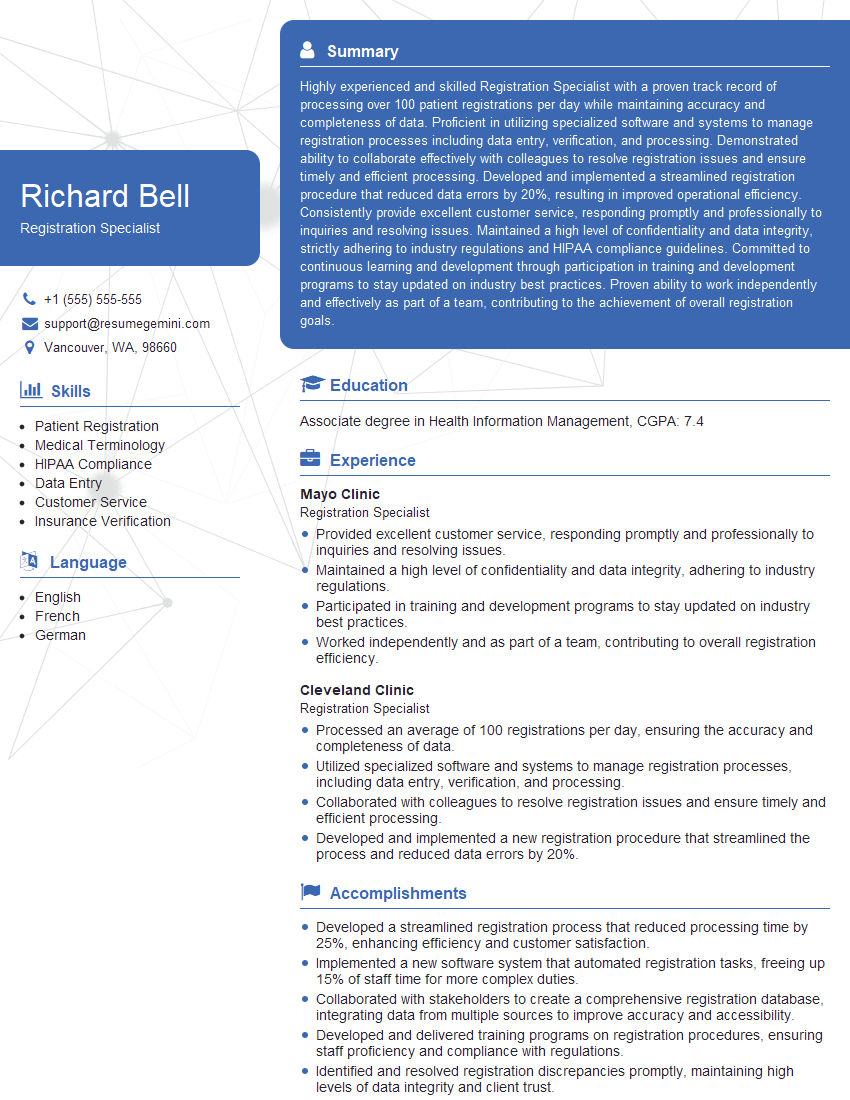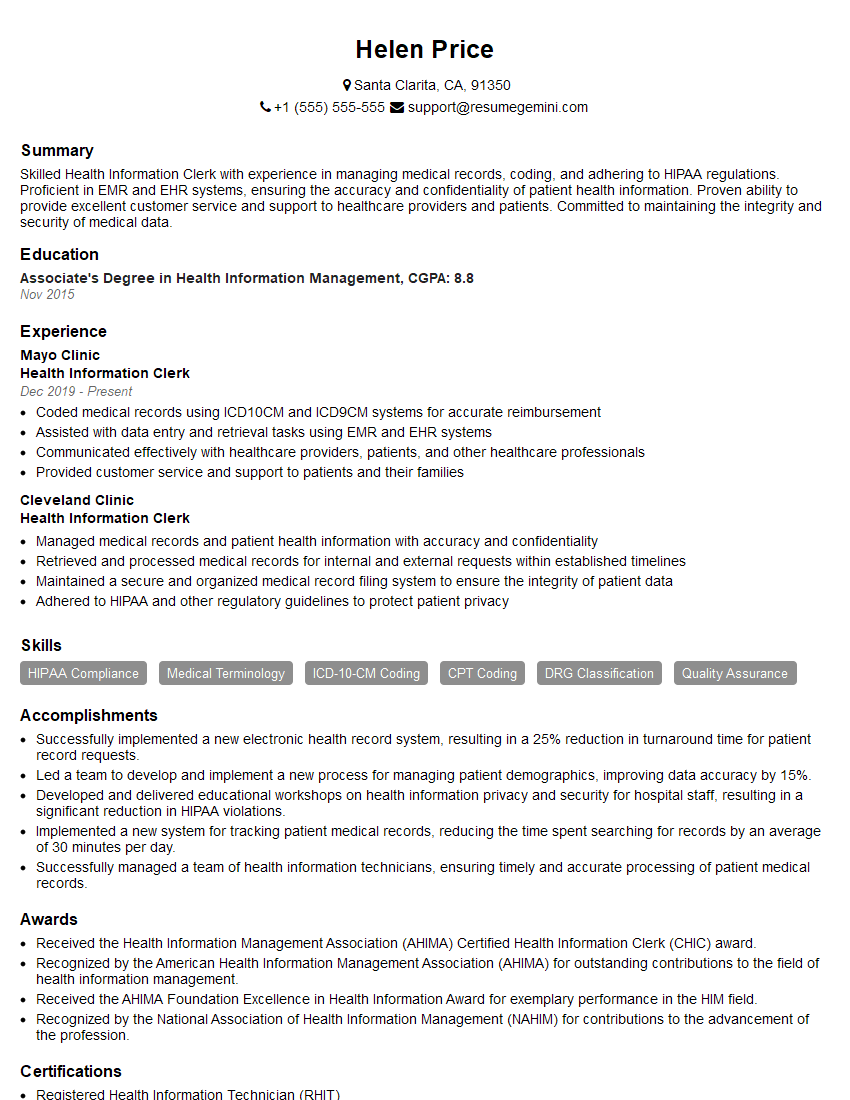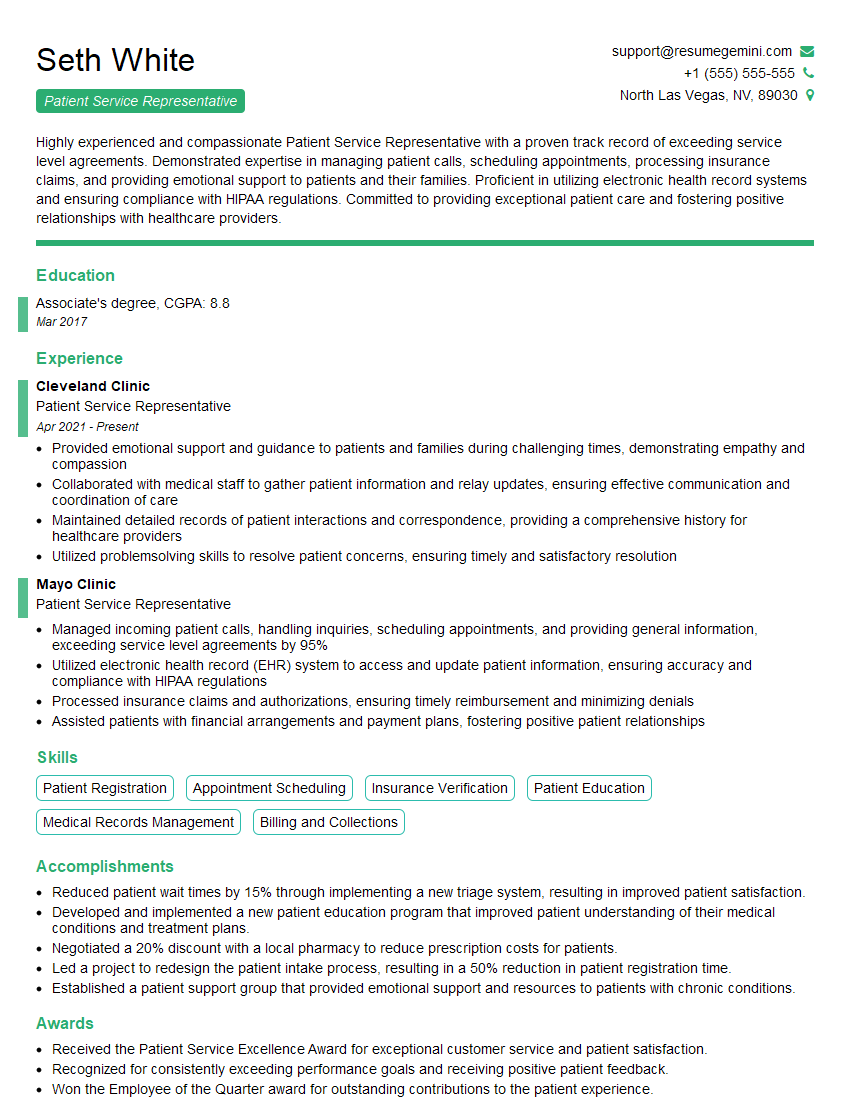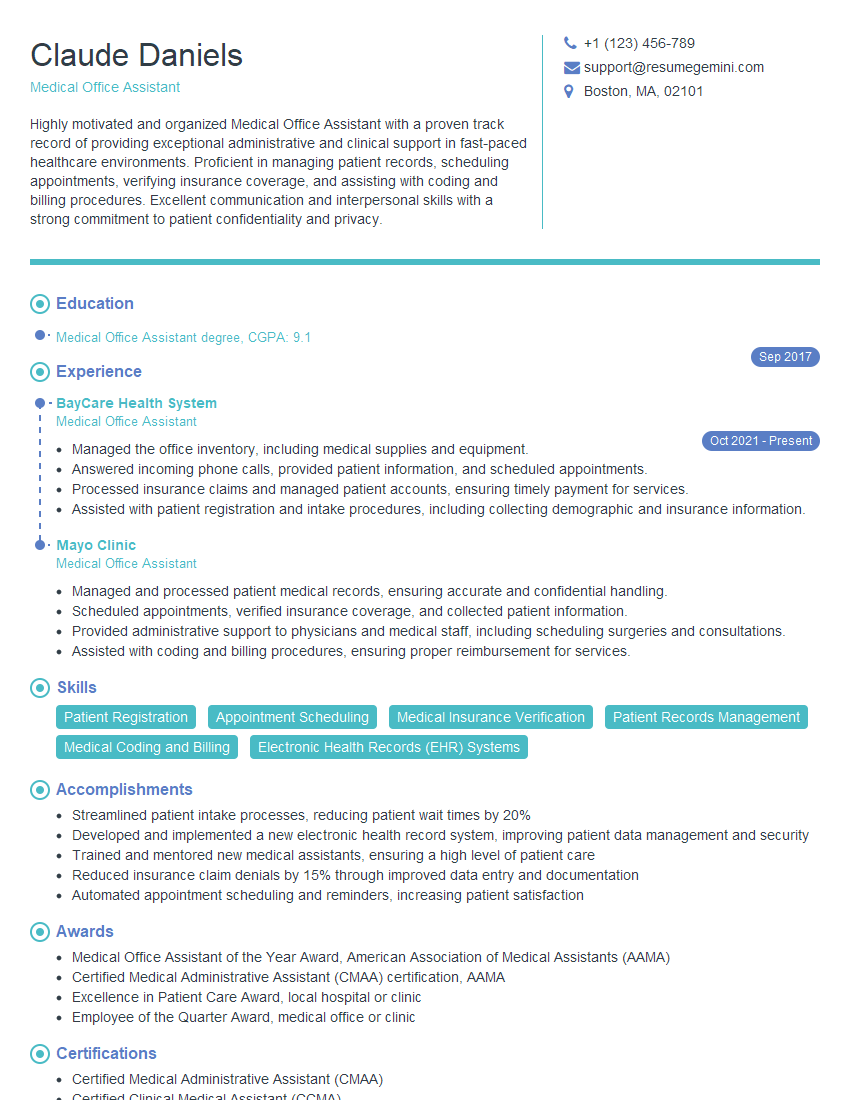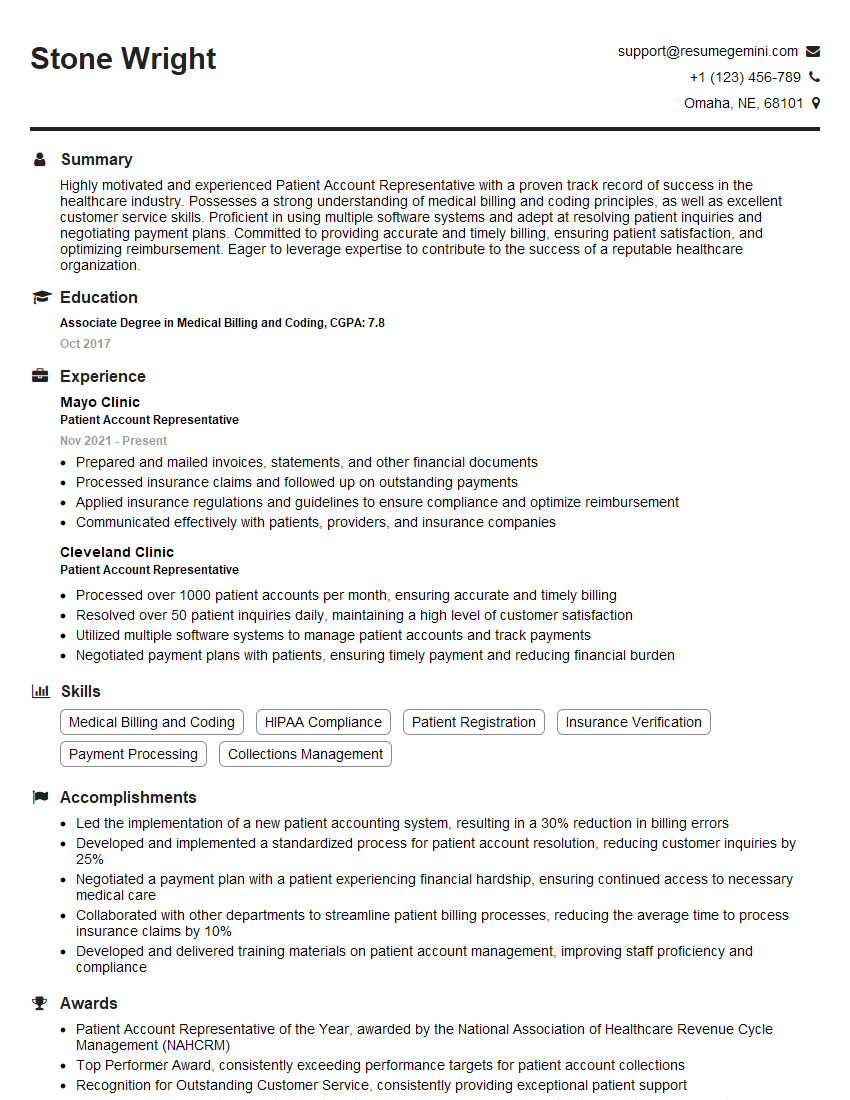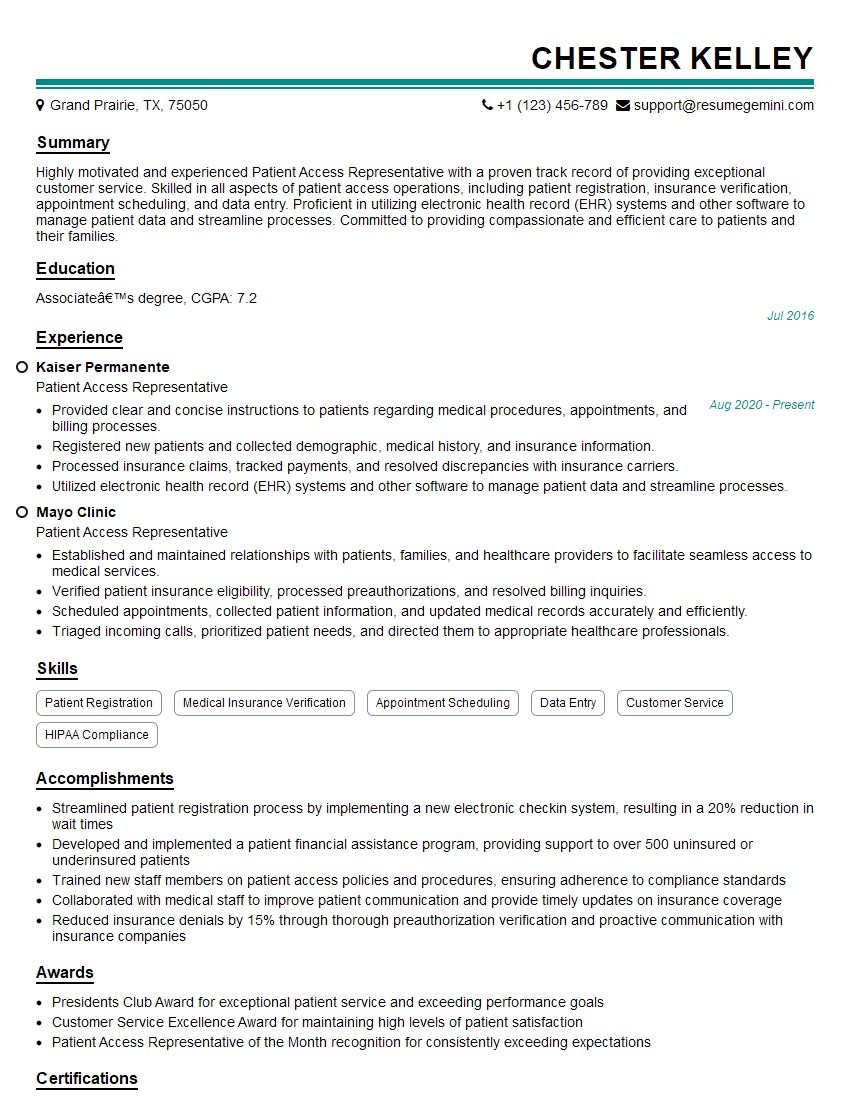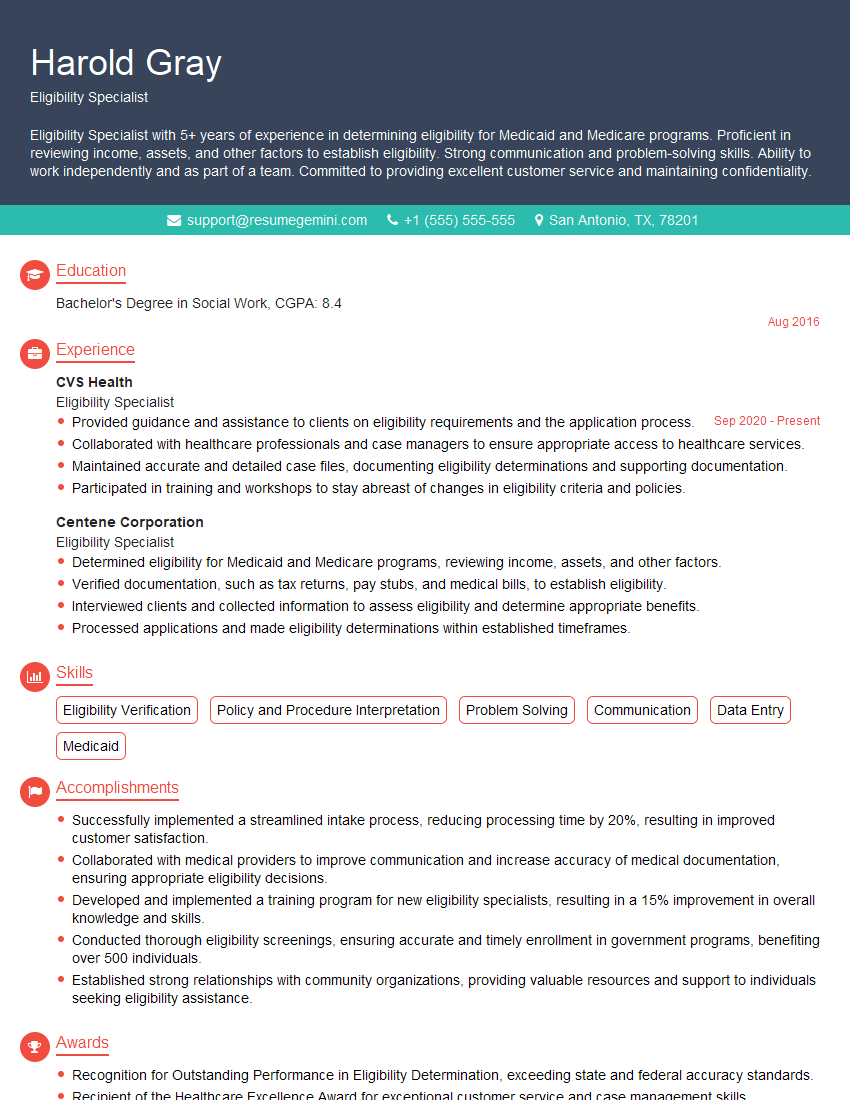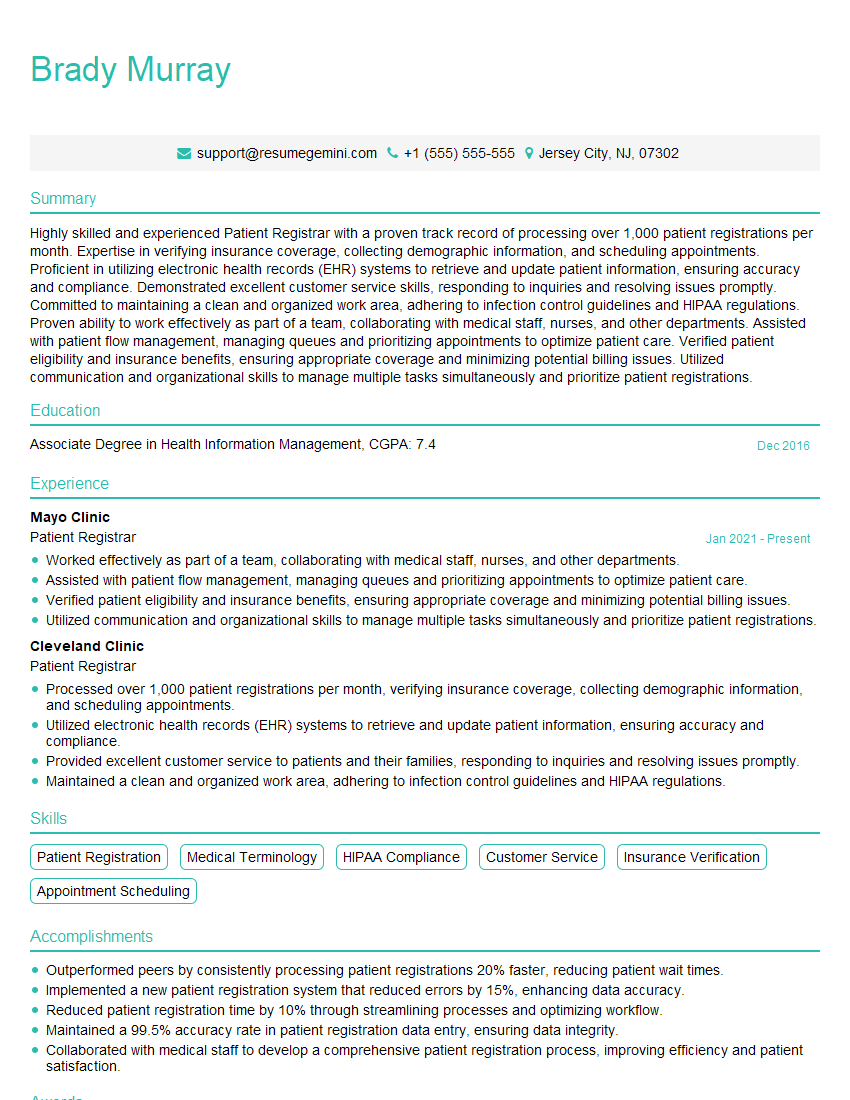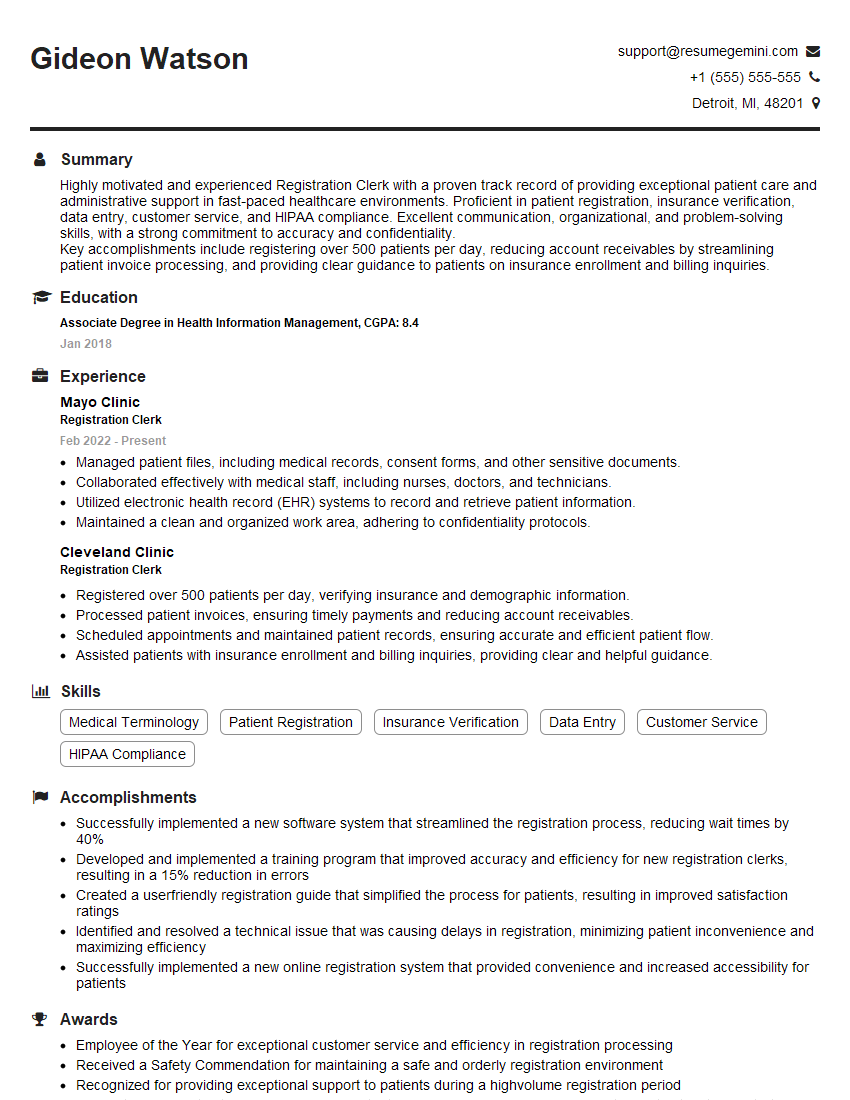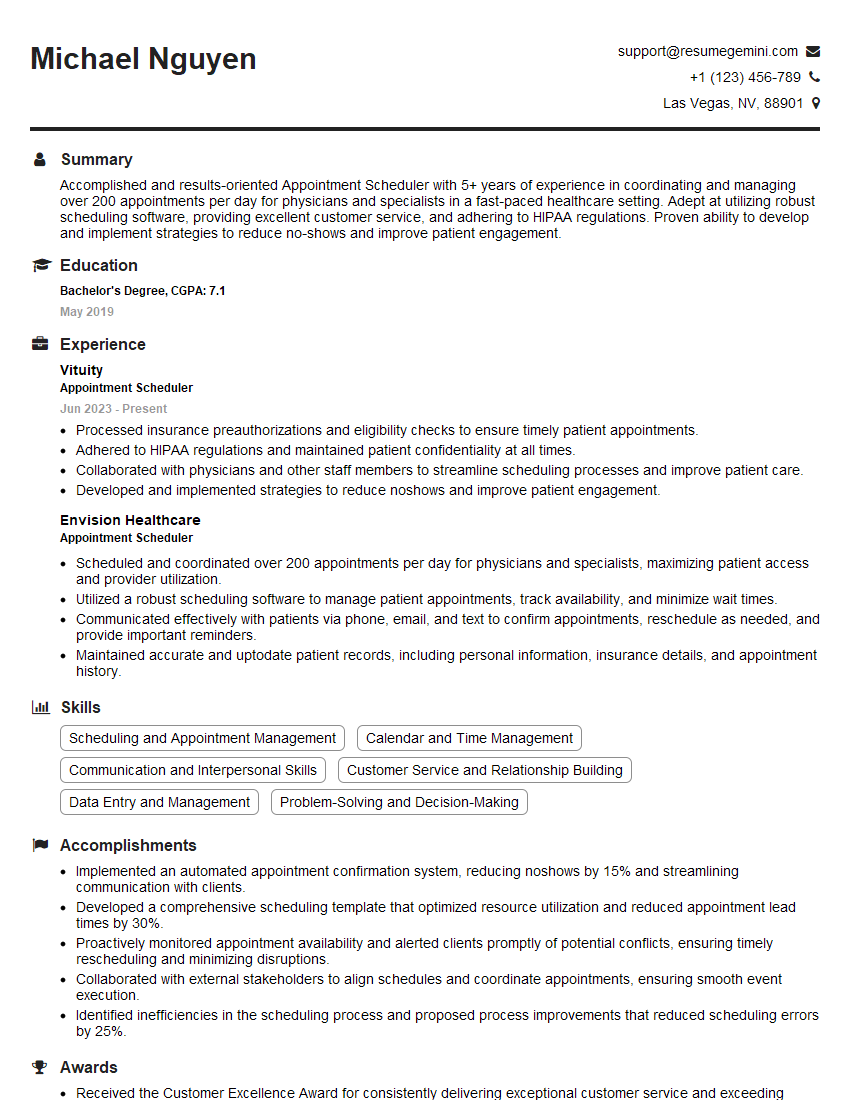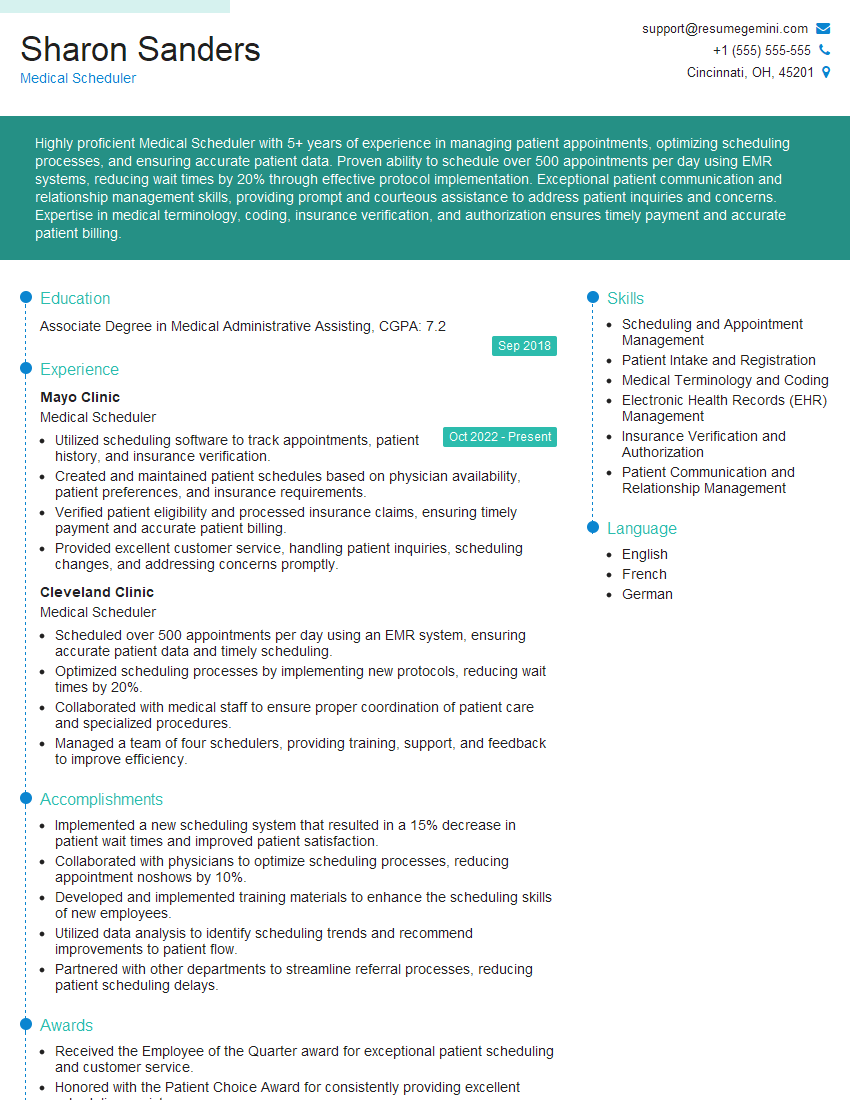Cracking a skill-specific interview, like one for Patient Registration and Scheduling, requires understanding the nuances of the role. In this blog, we present the questions you’re most likely to encounter, along with insights into how to answer them effectively. Let’s ensure you’re ready to make a strong impression.
Questions Asked in Patient Registration and Scheduling Interview
Q 1. Explain the process of patient registration from initial contact to appointment scheduling.
The patient registration process begins the moment a patient makes initial contact, whether by phone, online portal, or in person. It’s a crucial step ensuring a smooth patient journey and accurate record-keeping.
- Initial Contact & Information Gathering: This involves collecting essential demographic data like name, address, date of birth, contact information, and insurance details. We verify the information provided to the best of our ability at this stage.
- Insurance Verification: We immediately verify the patient’s insurance coverage, eligibility, and benefits to avoid surprises later. This might involve contacting the insurance provider directly or using online verification tools. (More on this in the next answer).
- Appointment Scheduling: Once insurance is verified (or if no insurance is needed), we schedule the appointment based on patient availability and physician schedule. We utilize scheduling software to ensure accurate booking and minimize conflicts.
- Data Entry and Confirmation: All gathered information is entered into the Electronic Health Record (EHR) system. This step includes double-checking all data for accuracy and providing the patient with appointment details and confirmation.
- Pre-Registration Forms: In some cases, patients complete pre-registration forms either online or in-person, streamlining the process and reducing wait times at the appointment. This is particularly useful for patients with complex medical histories.
For example, a new patient calling to schedule a check-up will go through each of these steps, culminating in a confirmed appointment. Efficient registration reduces patient wait times and ensures a positive first impression.
Q 2. Describe your experience with different insurance verification methods.
I have extensive experience with various insurance verification methods, both manual and automated. My experience encompasses working with different insurance providers and understanding their unique processes.
- Online Verification Systems: Many insurance companies offer online portals to verify eligibility and benefits. These systems are generally quick and efficient. I’m proficient in using several such systems.
- Direct Phone Calls: When online verification is unavailable or inconclusive, I directly call the insurance company to confirm details such as coverage, pre-authorization requirements, and co-pay amounts.
- Fax Verification: While less common now, faxing authorization forms is still a valid method, especially for specialized procedures or specific insurance providers.
- Claim Submission and Tracking Systems: Beyond verification, I’m skilled in submitting claims to insurance companies and tracking their status.
For instance, I recently encountered a situation where a patient’s online verification indicated no coverage. A direct phone call to the insurance company revealed a system error, and the patient indeed had coverage. Promptly resolving this potential issue saved both the patient and the practice significant time and stress.
Q 3. How do you handle a patient who is upset about appointment delays?
Handling upset patients is a critical skill in this role. My approach emphasizes empathy, clear communication, and finding solutions.
- Active Listening: I begin by actively listening to the patient, letting them express their frustrations without interruption. Acknowledging their feelings is paramount, even if I can’t immediately resolve the problem.
- Empathy and Understanding: I empathize with their situation and avoid becoming defensive. I try to understand their perspective and the reasons behind their frustration.
- Information and Explanation: Once the patient has finished expressing their concerns, I offer clear and concise information about the delay, explaining the reasons if possible, and avoiding medical jargon.
- Offering Solutions: Depending on the cause of the delay, I offer solutions such as rescheduling the appointment, offering alternative times, or explaining what steps will be taken to prevent similar delays in the future.
- Follow Up: A follow-up call or email expresses my continued concern and ensures the patient feels heard and valued.
For example, I once managed a situation where a patient was upset due to a significant appointment delay resulting from an unexpected equipment malfunction. By apologizing sincerely, explaining the situation, and immediately rescheduling the appointment with a convenient alternative time, I was able to diffuse the situation and retain the patient’s trust.
Q 4. What software programs are you proficient in for patient registration and scheduling?
I’m proficient in several software programs commonly used for patient registration and scheduling. My expertise extends to both their functional aspects and the integration of these systems within a healthcare setting.
- Epic: I have extensive experience using Epic’s scheduling and registration modules, including patient portal integration.
- Cerner: I am also proficient in Cerner’s Millennium system, understanding its workflows and functionalities for patient registration and scheduling.
- Allscripts: I possess a strong understanding of Allscripts’ scheduling software, including its features related to appointment management and insurance verification.
- NextGen: My experience includes using NextGen’s robust features for patient registration, appointment management, and reporting.
- Microsoft Office Suite: Proficiency in Excel, Word, and Outlook is crucial for managing patient data, generating reports, and communicating effectively.
My experience using these software programs is more than just using the interface; it involves understanding their data management capabilities, reporting features, and the ability to troubleshoot issues effectively. For example, I’ve successfully used Epic’s reporting tools to identify trends in appointment scheduling that allowed for optimization of clinic workflows.
Q 5. How do you ensure patient data accuracy and confidentiality?
Ensuring patient data accuracy and confidentiality is paramount. My approach involves a multi-layered strategy incorporating technology and strict adherence to best practices.
- Data Entry Verification: I always double-check all data entered into the EHR system, verifying accuracy against the information provided by the patient.
- Data Validation Tools: I utilize the data validation features built into EHR systems to flag inconsistencies and potential errors.
- Regular Data Audits: Participation in regular data audits helps maintain data integrity and identify areas for improvement in data entry procedures.
- Strict Adherence to Confidentiality Protocols: I strictly adhere to all confidentiality protocols, limiting access to patient data only to authorized personnel and using secure methods for data transmission.
- Password Protection and Access Control: I understand and follow facility policies concerning secure password practices and access control measures.
For instance, if I notice a discrepancy between the patient’s reported address and their insurance information, I immediately verify the information with the patient to ensure accuracy. This careful attention to detail prevents errors that could impact patient care or billing.
Q 6. Explain your understanding of HIPAA regulations and their relevance to patient registration.
HIPAA (Health Insurance Portability and Accountability Act) regulations are fundamental to patient registration. My understanding encompasses the key provisions and their practical application in daily operations.
- Patient Privacy and Confidentiality: HIPAA emphasizes the need for strict protection of patient information, requiring safeguards to prevent unauthorized access, use, or disclosure of Protected Health Information (PHI).
- Data Security: HIPAA mandates specific security measures to protect electronic PHI, including access controls, audit trails, and encryption.
- Patient Rights: Patients have the right to access, amend, and request restrictions on their PHI. I’m responsible for assisting patients in exercising these rights.
- Disclosure of Information: HIPAA governs the permissible uses and disclosures of PHI, ensuring compliance with all regulations regarding patient authorization and reporting requirements.
In my daily work, I meticulously follow HIPAA guidelines, such as confirming patient identity before disclosing any information, encrypting sensitive data during transmission, and ensuring only authorized personnel access patient records. Non-compliance can lead to severe penalties, so adhering to these regulations is non-negotiable.
Q 7. How do you prioritize tasks when faced with multiple urgent requests?
Prioritizing tasks when faced with multiple urgent requests requires a systematic approach. I use a combination of techniques to ensure efficiency and avoid overlooking critical items.
- Urgency and Importance Matrix: I assess each request based on its urgency and importance. This creates a clear hierarchy, allowing me to focus on the most critical tasks first.
- Time Management Techniques: I utilize time management techniques like time blocking and task batching to allocate time efficiently to different requests.
- Communication and Collaboration: When necessary, I communicate with colleagues and supervisors to coordinate efforts, delegate tasks, or request assistance.
- Regular Review and Adjustment: I regularly review my task list and adjust my priorities as needed based on changing circumstances or new information.
For example, if I simultaneously receive requests for urgent insurance verification, a patient needing an immediate appointment reschedule, and a large number of patient registration tasks, I’d prioritize the insurance verification and rescheduling (highest urgency, potentially impact patient care) before tackling the other registrations (high importance, but slightly less urgent).
Q 8. Describe your experience with managing patient appointment cancellations and rescheduling.
Managing appointment cancellations and rescheduling requires a proactive and organized approach. My experience involves utilizing a robust scheduling system to track cancellations, understanding the reasons behind them (illness, scheduling conflicts, etc.), and efficiently rescheduling appointments to minimize disruption to both the patient and the clinic’s schedule.
I follow a structured process: first, I document the cancellation reason in the EHR. Then, I immediately attempt to contact the patient to understand their situation and offer alternative appointment times. This often involves checking the physician’s availability and offering options within a reasonable timeframe. For instance, if a patient cancels due to a work conflict, I’d suggest evening or weekend appointments if available. If rescheduling isn’t possible, I carefully document this in the system and initiate a process to fill the vacated slot, perhaps by contacting patients on the waiting list.
For example, I once had a patient cancel due to a family emergency. After expressing my understanding and sympathy, I worked with the patient to reschedule their appointment for the following week, ensuring the physician was aware of the change and the reason for the delay. This demonstrates empathy and proactive problem-solving.
Q 9. How do you handle patient inquiries regarding insurance coverage and billing?
Handling patient inquiries about insurance coverage and billing necessitates clear communication, patience, and a strong understanding of insurance policies. I begin by verifying the patient’s insurance information, ensuring it’s accurately entered into the system. This usually involves confirming the patient’s name, date of birth, insurance provider, and policy number. I then utilize the EHR system to check their eligibility and benefits, explaining the patient’s copay, deductible, and any other out-of-pocket costs. I also clearly explain the billing process, payment options, and any financial assistance programs that might be available.
If a patient has questions about their bill, I provide a detailed explanation of each charge, referencing codes and procedures as needed. I strive to answer all questions thoroughly and professionally, often providing written summaries or referring them to the billing department for more complex issues. For instance, if a patient questions a particular charge, I would access the EHR to verify the service provided and explain it in simple terms, ensuring they understand the rationale behind the billing.
Q 10. How do you maintain a professional and courteous demeanor while managing a high volume of patients?
Maintaining a professional and courteous demeanor under pressure is crucial in this role. I believe in treating each patient as an individual, actively listening to their concerns, and addressing them with empathy and respect, even during high-volume periods. This involves prioritizing tasks effectively, using time management techniques, and maintaining a calm and positive attitude. I also utilize effective communication skills, such as clear and concise language, active listening, and appropriate body language.
In practice, this means I anticipate peak periods and plan accordingly. I might have pre-prepared materials for frequently asked questions or utilize a system of prioritizing urgent requests. I always acknowledge the patient, smile, and make eye contact to establish a positive rapport. If I’m facing a particularly challenging patient, I take a moment to compose myself before responding, ensuring my response is measured and professional. I see it as a balancing act between efficiency and personalized care.
Q 11. Describe your experience with electronic health records (EHR) systems.
I have extensive experience with various EHR systems, including Epic, Cerner, and Meditech. My proficiency encompasses patient registration, appointment scheduling, insurance verification, medical record maintenance, and report generation. I understand the importance of data integrity and accurate data entry within these systems. I can efficiently navigate the software, extract relevant information, and troubleshoot common issues.
For example, I am proficient in using Epic’s scheduling module to efficiently manage appointments, including assigning providers, managing waiting lists, and generating reports on appointment utilization. My experience also extends to using Cerner’s patient portal functionality to facilitate communication and patient self-service. I am adept at utilizing these systems to improve workflows and ensure accurate patient data management.
Q 12. How do you verify patient insurance eligibility and benefits?
Verifying patient insurance eligibility and benefits is a critical step in the registration process. I typically use online insurance verification systems or directly contact the insurance provider to confirm the patient’s coverage, including their eligibility, effective dates, coverage details, and any pre-authorization requirements. I carefully document all this information in the EHR, ensuring accuracy and consistency. For instance, I would confirm if the patient has met their deductible or if there are any specific limitations on coverage.
I often use the provider’s online portal or a dedicated insurance verification tool to swiftly check benefits. This information is vital for informing patients about their estimated out-of-pocket costs upfront. Any discrepancies are resolved by contacting the insurance company directly, and I always keep the patient informed throughout the process, ensuring transparency.
Q 13. How do you identify and resolve patient registration errors?
Identifying and resolving patient registration errors is crucial for efficient billing and accurate record-keeping. I utilize data validation tools within the EHR system to identify potential errors during data entry, including discrepancies in personal information, insurance details, and contact information. I then verify the information with the patient, correcting any mistakes immediately. This involves double-checking spellings, verifying addresses, and ensuring consistency between different data fields.
For example, if the system flags a mismatch between the patient’s date of birth and their insurance information, I immediately rectify the issue by clarifying the details with the patient and correcting the data in the system. I also run regular reports to identify potential systemic errors or areas requiring improvement in our registration processes.
Q 14. How do you manage no-shows and late arrivals?
Managing no-shows and late arrivals requires a multi-faceted approach. First, I implement strategies to reduce no-shows, such as sending automated reminders via text or email prior to appointments. For late arrivals, I develop a system to adjust the schedule when feasible. For persistent no-shows, I may implement a policy requiring pre-payment or cancellation fees.
When a patient is a no-show, I immediately document it in the EHR and, if appropriate, follow up with a phone call to understand the reasons. For late arrivals, I strive to accommodate them if possible, but it may involve rescheduling the appointment if the delay significantly impacts the provider’s schedule. This requires careful communication and coordination with the clinical team. Regular analysis of no-show patterns allows identification of areas for process improvement.
Q 15. Describe your experience with pre-registration processes.
Pre-registration is the process of collecting patient information before their actual appointment, streamlining the check-in process on the day of their visit. This can significantly reduce wait times and improve patient flow. My experience encompasses various methods, including phone registration, online portals, and paper forms.
For instance, I’ve worked extensively with an online portal that allowed patients to upload insurance information, complete medical history questionnaires, and even select their preferred appointment time. This reduced the administrative burden on the day of their visit, allowing us to focus on patient care. In another role, I managed a system where we proactively contacted patients before their scheduled procedure to confirm details and collect any missing information, preventing last-minute delays. We also utilized pre-registration to identify potential issues, like missing insurance information, so we could proactively address these concerns before the patient’s visit, leading to fewer appointment cancellations or reschedules.
Career Expert Tips:
- Ace those interviews! Prepare effectively by reviewing the Top 50 Most Common Interview Questions on ResumeGemini.
- Navigate your job search with confidence! Explore a wide range of Career Tips on ResumeGemini. Learn about common challenges and recommendations to overcome them.
- Craft the perfect resume! Master the Art of Resume Writing with ResumeGemini’s guide. Showcase your unique qualifications and achievements effectively.
- Don’t miss out on holiday savings! Build your dream resume with ResumeGemini’s ATS optimized templates.
Q 16. What is your experience with different types of appointment scheduling (e.g., block booking, open access)?
I’m experienced with various appointment scheduling methods. Block booking involves assigning specific time slots to providers for particular procedures or types of appointments. This is efficient for specialists or procedures requiring dedicated time. Open access, on the other hand, allows patients to book appointments whenever a slot is available, offering greater flexibility. I’ve also managed systems incorporating wave scheduling, which groups patients with similar needs into time blocks, optimizing provider time and minimizing patient wait times. Finally, advanced access aims to offer same-day or next-day appointments, improving patient access and potentially reducing the number of no-shows. Each method has its advantages and disadvantages depending on the specific needs of the practice and patient population. For example, a busy cardiology practice might use block booking to schedule complex procedures while a general practitioner’s office might prefer open access for greater patient convenience.
Q 17. How do you handle conflicting appointments or double bookings?
Conflicting appointments and double bookings are serious issues that need immediate attention. My approach involves a multi-step process. First, I use the scheduling system’s built-in conflict alerts to identify any overlaps. Then, I immediately contact the patients involved to explain the situation and offer alternative appointment times. If resolution requires rescheduling, I prioritize based on factors such as urgency and patient needs. Thorough documentation of the conflict, the resolution, and any communication with the patients is crucial for maintaining accurate records. For example, if a double booking occurs, I would contact both patients, apologize for the inconvenience, and offer the earliest available alternative time slots based on provider availability and the patients’ preferences. I would then make the necessary adjustments in the scheduling system and document everything in the patient’s chart to ensure transparency and accountability.
Q 18. Explain your experience with managing patient referrals.
Managing patient referrals involves meticulous attention to detail and clear communication. My experience includes receiving referrals from various sources – other physicians, specialists, and even self-referrals. The process typically begins with verifying the referral’s legitimacy and completeness. Then, I input the referral information into the system, ensuring all relevant data, such as the reason for referral and any accompanying medical records, is accurately recorded. Next, I schedule the appointment, taking into consideration the patient’s preferences and the specialist’s availability. Finally, I communicate the appointment details to both the referring physician and the patient. Using a robust system that integrates referral management with the scheduling system is crucial; this prevents errors and ensures timely processing of patient requests. Imagine a situation where a specialist needs specific lab results before seeing a patient. I’d work to ensure those results were readily available, facilitating a smoother transition and reducing wait times.
Q 19. How do you stay organized and manage your workload effectively?
Staying organized and managing my workload effectively is paramount in this role. I utilize a combination of strategies. First, I prioritize tasks based on urgency and importance, using tools like daily to-do lists. Second, I utilize the scheduling system’s reporting features to monitor key metrics like appointment wait times and patient volume, allowing me to identify potential bottlenecks and adjust my workflow accordingly. Third, I leverage technology efficiently; this includes utilizing electronic health records (EHR) systems to manage patient data and using calendar applications to schedule and track appointments. Fourth, regular breaks throughout the day aid concentration and prevent burnout. A proactive approach, anticipating potential issues and implementing preventative measures (like sending reminders) avoids last-minute rushes and stress. For example, setting aside 15 minutes at the end of each day to review my schedule for the next day significantly reduces morning stress and keeps me ahead of the curve.
Q 20. Describe your experience with various payment methods and processing patient payments.
I have experience processing payments through various methods, including credit cards, debit cards, cash, and checks. Compliance with HIPAA regulations regarding patient financial information is paramount. I’m familiar with using medical billing software to record payments, generate receipts, and manage outstanding balances. Properly recording transactions and balancing daily accounts are essential for financial accuracy. Additionally, I’m adept at explaining payment options to patients and addressing any questions or concerns they may have. My experience includes handling insurance claims, processing co-pays, and explaining patient responsibility for services rendered. For example, if a patient has a high deductible plan, I would clearly explain their out-of-pocket responsibility and payment options to ensure financial clarity and satisfaction.
Q 21. How do you ensure the timely processing of patient registration information?
Timely processing of patient registration information is critical for smooth patient flow and efficient practice operations. My approach focuses on accuracy and speed. I utilize electronic health record systems that automate many aspects of the registration process. I implement strict data-entry protocols, including double-checking information for accuracy and ensuring all required fields are completed. I also prioritize incoming registration tasks, handling urgent requests first. The use of templates and standardized forms further streamlines the process. Regular system checks for updates and potential errors prevent data loss and inaccuracies. For example, if a patient’s insurance information is incomplete, I immediately reach out to the patient to obtain the missing data, preventing delays in appointment scheduling or processing claims. The focus is always on data accuracy and avoiding any unnecessary administrative hurdles for both the patient and the staff.
Q 22. How do you communicate effectively with patients, physicians, and other healthcare professionals?
Effective communication is the cornerstone of successful patient registration and scheduling. I tailor my approach to the audience. With patients, I prioritize empathy and clear, concise language, avoiding medical jargon. I actively listen to their concerns, answer their questions patiently, and ensure they understand the next steps. For example, if a patient is anxious about a procedure, I’ll take the time to explain the process in simple terms and address their worries. With physicians, I communicate professionally and efficiently, providing accurate and timely information regarding appointment availability, patient demographics, and any relevant clinical information. I use concise summaries and prioritize critical data, perhaps using a standardized format for communication like a brief email outlining key patient details prior to the appointment. Finally, with other healthcare professionals, like nurses or billing staff, I maintain professional and collaborative communication. I leverage shared systems and workflows for efficient data exchange and ensure clarity on shared responsibilities, for example by using clear and specific messaging in electronic health records (EHR) when updating a patient’s record after a registration update.
Q 23. Describe a challenging situation you encountered in patient registration and how you resolved it.
In a previous role, we experienced a system-wide outage during peak registration hours. Patients were becoming increasingly frustrated, and the wait times were significantly exceeding our target. My immediate response was to activate our contingency plan, which included rerouting patients to manual registration methods. I also mobilized the team, assigning roles such as patient liaison, data entry support, and communications management. We ensured patients were informed about the situation and offered alternative means of contact for scheduling, like a callback system. Once the system was restored, we reviewed the situation, identified the weaknesses in our disaster recovery plan, and implemented improvements to minimize the impact of future outages. This included training additional staff on the manual registration process and investing in backup systems with redundant capabilities. The key lesson learned was the importance of a robust contingency plan and strong team coordination during unforeseen crises.
Q 24. What are your strengths and weaknesses in relation to this role?
My strengths lie in my meticulous attention to detail, my proficiency in various patient registration and scheduling software (Epic, Cerner, etc.), and my exceptional organizational skills. I excel at prioritizing tasks, managing multiple appointments simultaneously, and ensuring accuracy in patient data entry. I’m also a highly adaptable and quick learner. I can quickly grasp new systems and procedures. However, my weakness is occasionally taking on too much responsibility, potentially impacting my work-life balance. I am actively addressing this by learning better time management techniques and delegating tasks when appropriate. I also utilize project management tools to stay organized and track my progress.
Q 25. Why are you interested in this position?
I’m highly interested in this position because it aligns perfectly with my skills and passion for patient care. Your organization’s commitment to providing high-quality, patient-centered care resonates deeply with my values. The opportunity to work with a team dedicated to providing exceptional patient experiences while utilizing the latest technology is particularly exciting, especially given my experience with [mention specific software or system if applicable]. I’m also eager to contribute to the continued success of your registration and scheduling department.
Q 26. What are your salary expectations?
My salary expectations are in line with the market rate for a professional with my experience and skills in this specific region. I’m open to discussing a specific range once I’ve learned more about the compensation and benefits package offered by your organization.
Q 27. Do you have any questions for me?
Yes, I have a few questions. I’d be interested in learning more about the specific technologies used in your registration and scheduling department and the team’s current workflow. I’d also appreciate hearing more about opportunities for professional development and career advancement within your organization.
Q 28. What is your experience with patient portal management?
My experience with patient portal management encompasses both technical and customer service aspects. I’m proficient in assisting patients with account creation, password resets, and navigating the portal’s features. I also have experience troubleshooting technical issues, educating patients on portal usage, and ensuring compliance with HIPAA regulations regarding protected health information (PHI). I understand the importance of keeping patient data secure and up-to-date, and I’m accustomed to working within the established protocols for managing patient access to their own health information. For example, I’ve successfully trained patients in utilizing the portal to request medication refills, view test results, and schedule follow-up appointments, significantly improving their engagement with their healthcare.
Key Topics to Learn for Patient Registration and Scheduling Interview
- Understanding HIPAA Compliance: Learn the intricacies of patient privacy and data security regulations, and how they apply to registration and scheduling processes. Practical application: Explain how you would handle a situation where a patient’s information is accidentally disclosed.
- Mastering Electronic Health Records (EHR) Systems: Gain proficiency in using various EHR systems for patient registration, appointment scheduling, and data management. Practical application: Describe your experience with different EHR systems and how you optimized your workflow within them.
- Insurance Verification and Pre-Authorization: Develop expertise in verifying patient insurance coverage, obtaining pre-authorization for procedures, and understanding different billing processes. Practical application: Illustrate how you would handle a patient with complex insurance coverage.
- Patient Communication and Customer Service: Practice effective communication techniques to provide exceptional patient service, addressing inquiries and resolving conflicts professionally. Practical application: Detail how you’d manage a frustrated patient who is experiencing scheduling difficulties.
- Scheduling Optimization and Workflow Efficiency: Learn strategies for optimizing appointment scheduling to maximize clinic efficiency, minimize wait times, and improve patient flow. Practical application: Explain how you would improve the scheduling process in a busy clinic.
- Data Entry Accuracy and Quality Control: Understand the importance of accurate data entry and maintaining high data quality standards to ensure accurate billing and reporting. Practical application: Describe your method for identifying and correcting errors in patient data.
- Problem-Solving and Conflict Resolution: Prepare examples demonstrating your ability to handle unexpected challenges and resolve conflicts effectively in a fast-paced environment. Practical application: Describe a time you had to solve a scheduling conflict involving multiple patients and healthcare providers.
Next Steps
Mastering Patient Registration and Scheduling is crucial for career advancement in the healthcare field. It demonstrates your ability to contribute directly to efficient patient care and positive patient experiences. To significantly boost your job prospects, creating an ATS-friendly resume is essential. ResumeGemini is a trusted resource for building professional and effective resumes that get noticed. We provide examples of resumes tailored to Patient Registration and Scheduling to help you present your skills and experience in the best possible light. Take advantage of these resources to elevate your job search and secure your dream role.
Explore more articles
Users Rating of Our Blogs
Share Your Experience
We value your feedback! Please rate our content and share your thoughts (optional).
What Readers Say About Our Blog
Interesting Article, I liked the depth of knowledge you’ve shared.
Helpful, thanks for sharing.
Hi, I represent a social media marketing agency and liked your blog
Hi, I represent an SEO company that specialises in getting you AI citations and higher rankings on Google. I’d like to offer you a 100% free SEO audit for your website. Would you be interested?
